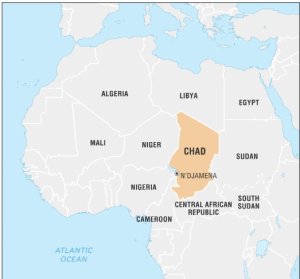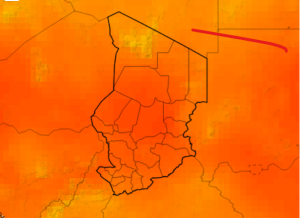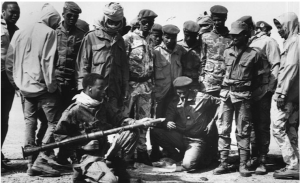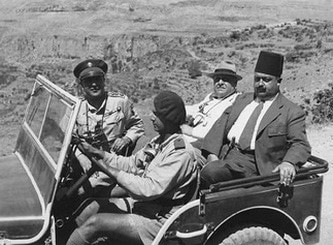Location, size and population

Chad is a landlocked country located in the middle region of Africa. The topography exhibits a constricted basin-like formation, encompassed by mountainous terrain in the northern, eastern, and southern directions. The elevation gradually increases as one moves eastward from the vicinity of Lake Chad. The Chari and Logone rivers, together with their respective tributaries, provide the only natural irrigation supplies that traverse the southeastern region and ultimately discharge into Lake Chad. The ports along the western African coastline are situated around 1,000 miles (1,600 km) away from the capital city of N’Djamena, once known as Fort-Lamy.
The northern border of Libya is shared with Chad, while its eastern border is next to Sudan. To the south, Libya has a border with the Central African Republic. On the western side, Libya is bordered by Cameroon, Nigeria, and Niger. The current borders of Chad, established during the colonial era, do not align with either ethnic or geographical boundaries.
During the early Holocene Epoch, it is estimated that the lake’s maximum depth reached around 550 feet (170 meters). This condition likely persisted until approximately 7,000 years ago. Furthermore, the lake existed at an elevation of approximately 1,100 feet (335 meters) above sea level, which is approximately 180 feet (55 meters) higher than its current level. During the period under consideration, the geographical expanse referred to as Mega-Chad included around 130,000 square miles (336,700 square kilometers). This vast region extended in a southerly direction along the present-day Kébi River, thereafter progressing westward through the Gauthiot Falls, until reaching the Benue River and ultimately the Atlantic Ocean. Chad has a population of around 18,523,000 people. Additionally, the presence of ancient dune systems that were submerged by the formation of Mega-Chad has resulted in the formation of elongated islands inside the present-day lake. These islands extend for several hundred kilometers towards the eastern region. The interdunal hollows within these islands are populated by diatomites and other sedimentary deposits originating from the lake.
Climate

Chad has a significant range of latitudes, extending over 15° south of the Tropic of Cancer. This geographical characteristic gives rise to a diverse array of climates, including both tropical wet and dry conditions as well as arid and desert-like environments. The annual precipitation in the villages of Moundou and Sarh, located in the wet and dry tropical zone, ranges from 32 to 48 inches (800 to 1,200 mm) over the period from May to October. N’Djamena, situated in the central semiarid tropical (Sahel) region, has an annual precipitation range of 12 to 32 inches (300 to 800 mm) throughout the period spanning from June to September. The occurrence of precipitation in the northern region is seldom, particularly at Largeau, where the annual average rainfall is less than one inch.
Consequently, Chad has a single, concise period of rainfall. The nation has a dry season that spans from December to February over the whole country. This season is characterized by relatively low temperatures, with daily highs ranging from the mid-80s to mid-90s Fahrenheit (upper 20s to mid-30s Celsius), and nighttime lows in the mid-50s Fahrenheit (low to mid-10s Celsius). Starting in the month of March, the temperature rises significantly until the occurrence of the first substantial precipitation events. For example, during the period from March to June, N’Djamena has daily average high temperatures above 100° F (38° C). N’Djamena has a period of intense precipitation beginning in July, resulting in a decrease in average day temperatures to around the low 90s Fahrenheit (mid-30s Celsius). Throughout this period, nocturnal temperatures remain in the 70s Fahrenheit (20s Celsius) until November, when the dry and cool season begins.
Languages
Within the confines of the country, a multitude of over 100 unique languages and dialects are spoken by its inhabitants. Although comprehensive data for many of these languages are lacking, they may be classified into the following twelve categories: The linguistic landscape of Chad is characterized by several distinct language groups. The Mundang-Tuburi-Mbum group is spoken by a significant population in the southwestern region of the country. Another prominent group is the Chado-Hamitic, which shares linguistic similarities with the Hausa language spoken in Nigeria. The Kanembu-Zaghawa languages, primarily used by nomadic communities in the northern part of Chad, also form a distinct language group. The Sara-Bongo-Bagirmi group represents languages spoken by approximately one million individuals in the southern and central regions of Chad. Additionally, the Maba group is extensively spoken in the Ouadda area of eastern Chad, particularly in close proximity to Abéché. The Tama languages are prevalent in districts such as Abéché, Adré, Goz Béda, and Am Dam. Daju languages are spoken in Goz Béda and Am Dam. Furthermore, various Central African languages are spoken in the southern region of Chad, including Sango (which is also the official language of the Central African Republic), the Bua group in southern and central Chad, the Somrai group in western and central Chad, the Mimi group in the far east, and the Fur group.
History

After gaining independence, Chad had a multitude of challenges, including a surge in violent crime and several other issues. In 1966, Africa saw the commencement of one of its lengthiest civil battles. The cessation occurred just during the first years of the 1990s, after a duration exceeding 24 years. The first signs of instability were apparent shortly after achieving independence. Following Chad’s attainment of independence, Francois Tombalbaye, the first president, implemented a system wherein decision-making authority was concentrated within the executive branch. Consequently, the function of parliament was reduced to that of a mere formality, without substantial influence or power. By 1962, President Tombalbaye had transformed Chad into a one-party state by eliminating all officially recognized opposition parties and ridding the nation of all individuals seen as rivals.
Subsequently, Tombalbaye implemented a policy aimed at ensuring that newly recruited civil servants only originated from the southern Sara tribe. Consequently, the nation had significant conflicts between its northern and southern areas. Historical conflicts that before the era of colonization resurfaced due to the absence of the northern region from state affairs and the civil service. The implementation of a new tax on livestock and personal income by the President in 1965 resulted in an immediate outbreak of violence against tax collectors in the northern areas. This situation further intensified the preexisting dispute. The northern Tubu ethnic group engaged in an act of rebellion against the governing authority, resulting in the unfortunate death of a Chadian military personnel. This event subsequently triggered a response from the government. Following the government’s retaliatory actions, the Tubu rebels sought refuge in Libya. Regrettably, it did not need a significant amount of time for a civil conflict to ensue between the mostly Christian/animist region in the south and the largely Muslim region in the north. The establishment of the Front de Libération Nationale (FROLINAT) took place on June 22, 1966, in Sudan, led by a collective of Muslim intellectuals and nationalists, with Ibrahim Abatcha assuming the position of general secretary within the organization.
There is much debate over the underlying factors that have contributed to the prolonged duration of Chad’s civil war. The first explanation mostly centers on the challenges that arose subsequent to 1960 as a result of President Tombalbaye’s endeavor to assume control. Through the concentration of authority within the presidency and the PPT (a political party that lacked substantial representation of the Chadian populace), the leader fostered a sense of estrangement among the Muslim population. In 1963, the Muslim community in Chad resorted to violent rioting in response to an endeavor aimed at acquiring political authority. President Tombalbaye effectively eradicated the last vestiges of democracy inside the country by systematically eliminating any dissenting voices from the National Assembly. Subsequent to these occurrences, there ensued a period of political turmoil and a series of governmental overthrows. The leadership of Tombalbaye exhibited a progressive inclination towards authoritarian measures, ultimately leading to a coup in 1975 orchestrated by General Felix Malloum with the aim of assuming power. Following a subsequent coup in 1979, Goukouni Wedei assumed his position. The administration had two further instances of overthrow, first by Hissène Habré in 1982 and subsequently by Idriss Déby in 1990.
The potential explanation for Chad’s history of violence may also be attributed to its colonial legacy under French rule, which overlooked the longstanding religious divide between the mostly Muslim north and the predominantly Christian south. Furthermore, the colonial administration’s neglect of the northern regions throughout the process of developing the southern regions resulted in unresolved challenges that persisted into the post-colonial era. Furthermore, the colonial system resulted in the establishment of undeveloped public institutions and governmental apparatuses that lacked substantial popular backing. The civil unrest in Chad may be attributed to a confluence of factors, including political instability and historical conflicts stemming from the colonial past. These underlying issues were further exacerbated by external influences.




